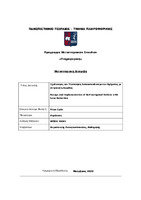Σχεδιασμός και υλοποίηση αυτοκατευθυνόμενου οχήματος με ανίχνευση λωρίδας
Design and implementation of self-navigated vehicle with lane detection

Προβολή/
Λέξεις κλειδιά
Αυτοκατευθυνόμενο όχημα ; Ανίχνευση λωρίδας ; Υπολογιστική όραση ; Αλγόριθμος ανίχνευσης λωρίδαςΠερίληψη
Σκοπός της παρούσας εργασίας είναι η μελέτη της κατασκευής ενός αυτοκατευθυνόμενου οχήματος, που ανιχνεύει και ακολουθεί μία λωρίδα. Επί της ουσίας, αποτελεί μία προσπάθεια σύζευξης κατάλληλου υλικού και λογισμικού ούτως ώστε να κατασκευαστεί ένα μοντέλο οχήματος με δυνατότητα αυτόνομης κατεύθυνσης, η οποία ορίζεται μέσω του εντοπισμού λωρίδας. Για τον εντοπισμό λωρίδας χρησιμοποιήθηκε κάμερα συνδεδεμένη με υπολογιστή μονής πλακέτας και τοποθετήθηκαν σε τρισδιάστατα εκτυπωμένο σκελετό. Για την κίνηση του οχήματος χρησιμοποιήθηκαν δύο σερβομηχανές. Η διαδικασία κίνησης και εντοπισμού της λωρίδας και οι αντίστοιχοι αλγόριθμοι υλοποιήθηκαν σε γλώσσα προγραμματισμού python. Επιπλέον, χρησιμοποιήθηκε υπολογιστική όραση για τον εντοπισμό της λωρίδας. Η εργασία είναι χωρισμένη σε έξι θεματικές ενότητες :
Στο πρώτο μέρος παρουσιάζεται η υπολογιστική όραση από θεωρητική σκοπιά και σε συνδυασμό με τα αυτοκατευθυνόμενα οχήματα, καθώς και άλλες εφαρμογές της.
Στο δεύτερο τμήμα περιγράφεται το υλικό που χρησιμοποιήθηκε για την κατασκευή του οχήματος.
Το τρίτο σκέλος της εργασίας αναφέρει το λογισμικό και τις βιβλιοθήκες που θεωρήθηκαν κατάλληλες για τις λειτουργείες του συγκεκριμένου οχήματος
Το τέταρτο τμήμα αποτελεί την αναλυτική παρουσίαση της συνδεσμολογίας του αυτοκατευθυνόμενου οχήματος
Στο πέμπτο μέρος παρουσιάζεται οι αλγόριθμοι της ανίχνευσης λωρίδας με κάθε λεπτομέρεια.
Στο έκτο σκέλος υπάρχουν τα συμπεράσματα του εγχειρήματος καθώς και οι δυσκολίες που αντιμετωπίστηκαν κατά την κατασκευή , όπως και οι μελλοντικές βελτιώσεις που θα μπορούσαν να εφαρμοστούν.

